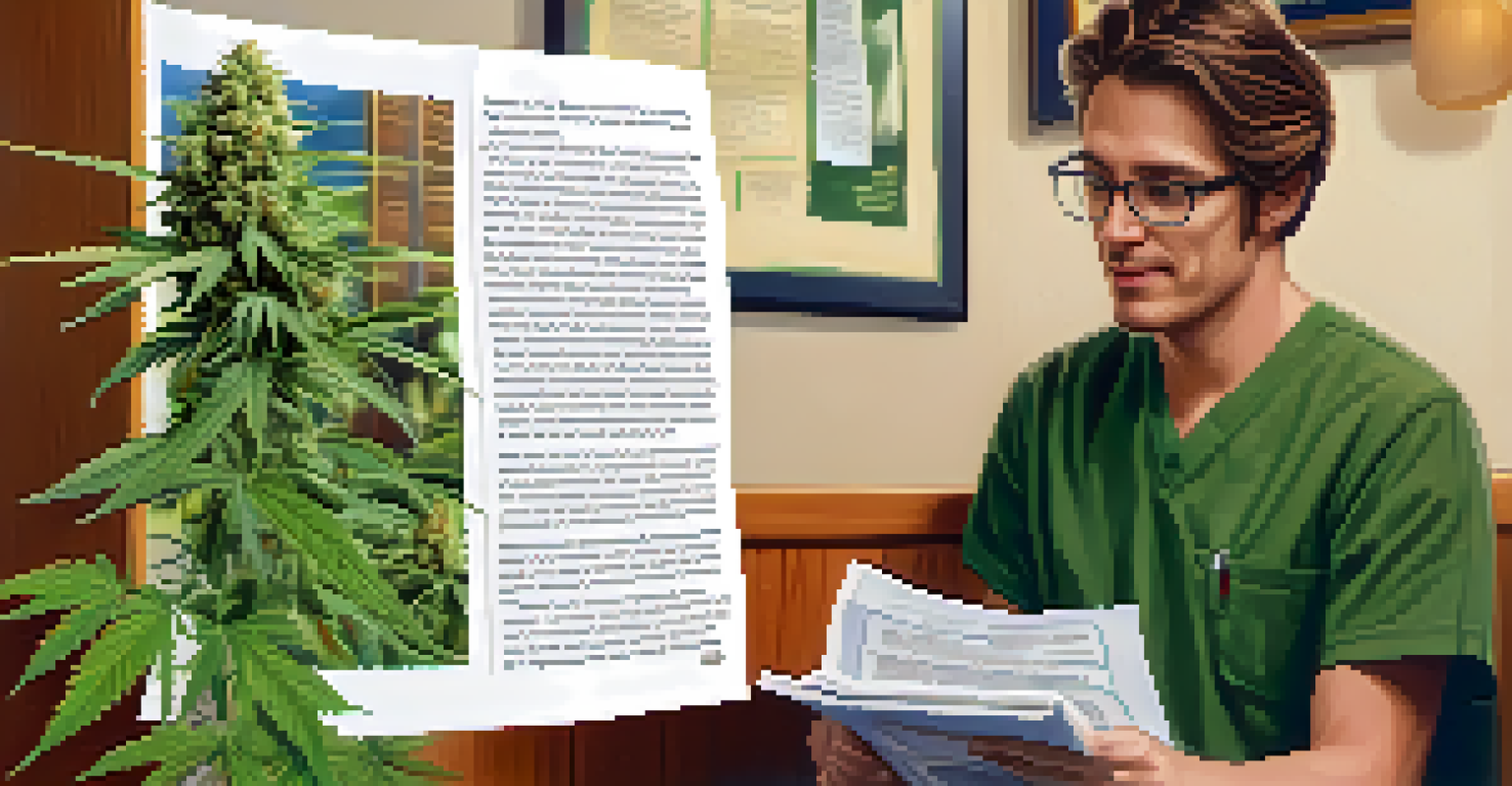The Impact of Medical Marijuana on Public Perception

Understanding Medical Marijuana: A Brief Overview
Medical marijuana refers to the use of cannabis for therapeutic purposes, prescribed by healthcare professionals. It’s distinct from recreational use, focusing on alleviating symptoms of various medical conditions. As more states and countries legalize its use, awareness grows, leading to discussions about its benefits and risks.
The greatest weapon against stress is our ability to choose one thought over another.
The scientific community has increasingly researched the effects of cannabinoids, the active compounds in cannabis, on health. Patients report relief from chronic pain, anxiety, and other ailments, which challenges long-held stigmas around marijuana use. This shift in understanding is crucial as society grapples with the complexities of cannabis in medicine.
However, the conversation about medical marijuana is often clouded by misinformation and longstanding stereotypes. By providing clear, evidence-based information, we can foster a more informed public discourse that reflects the nuances of this topic.
Changing Attitudes: The Role of Legalization
As more regions legalize medical marijuana, public attitudes are shifting dramatically. Surveys show that acceptance of cannabis for medical use has grown, with many viewing it as a legitimate treatment option. This change is often driven by personal stories and the visible benefits experienced by patients.

Legalization not only affects individual perspectives but also influences broader societal norms. When law changes, it often leads to greater visibility and acceptance, encouraging conversations that were once taboo. This ripple effect can significantly alter how communities perceive cannabis overall.
Evolving Views on Medical Marijuana
Public attitudes are shifting as more states legalize medical marijuana, leading to greater acceptance and understanding of its therapeutic benefits.
The impact of legalization is also seen in healthcare settings, where more physicians are willing to discuss cannabis as a treatment. This shift further normalizes the conversation around medical marijuana, helping to reduce stigma and promote understanding.
Media Representation: Shaping Public Perception
Media plays a crucial role in shaping public perception of medical marijuana. Documentaries, news articles, and social media campaigns can highlight both the benefits and the controversies associated with cannabis use. This representation often influences how people view its legitimacy as a medical treatment.
In the midst of movement and chaos, keep stillness inside of you.
Positive media stories tend to humanize the issue, showcasing real patients and their journeys with medical marijuana. These narratives can evoke empathy and understanding, encouraging more people to reconsider their biases. Conversely, negative portrayals can reinforce stereotypes and fears, showcasing the delicate balance media must maintain.
As consumers of media, it's essential to critically evaluate the information presented. Understanding the motivations behind certain narratives can help foster a more comprehensive view of medical marijuana and its place in society.
Personal Experiences: The Power of Patient Advocacy
Personal stories from patients using medical marijuana can have a profound impact on public perception. When individuals share their experiences—especially when traditional treatments have failed—it humanizes the issue. These testimonials often resonate more deeply than statistics or scientific studies alone.
Patient advocacy groups play a significant role in this narrative, promoting awareness and understanding of medical marijuana. They help connect patients with resources, share their stories, and educate the public about the potential benefits and challenges of cannabis use. This grassroots movement has been instrumental in changing hearts and minds.
Media's Influence on Perception
Media representation plays a crucial role in shaping public views on medical marijuana, highlighting both its benefits and the controversies surrounding its use.
As these stories gain visibility, they challenge preconceived notions about marijuana use and encourage a more compassionate dialogue. This shift not only influences how individuals view medical marijuana but also impacts policymakers and the healthcare community.
The Generational Divide: Attitudes Toward Cannabis
There is often a striking generational divide in attitudes toward medical marijuana. Younger generations tend to be more accepting, viewing cannabis as a viable alternative for various health issues. This acceptance is often rooted in their exposure to cannabis culture and the changing legal landscape.
On the other hand, older generations may hold onto traditional views that demonize marijuana use. Their perspectives are often shaped by historical stigma and a lack of familiarity with its medical applications. Bridging this gap requires education and open dialogue to foster understanding across age groups.
As younger generations continue to advocate for cannabis use, we may see further changes in public perception. This generational shift can lead to more progressive policies and a greater acceptance of medical marijuana in mainstream society.
Challenges and Misconceptions in Public Perception
Despite the growing acceptance of medical marijuana, misconceptions still abound. Many people conflate medical use with recreational use, viewing all cannabis as dangerous or untrustworthy. This misunderstanding can hinder the progress made toward broader acceptance and access to medical marijuana.
The stigma surrounding cannabis can also deter patients from seeking medical advice or treatment. Fear of judgment or discrimination may prevent individuals from exploring options that could significantly enhance their quality of life. Addressing these misconceptions is crucial for fostering a more inclusive conversation about medical marijuana.
Patient Stories Drive Change
Personal experiences shared by medical marijuana patients significantly impact public perception, promoting compassion and understanding towards cannabis as a treatment option.
Educational initiatives aimed at dispelling myths and providing accurate information are essential. By clarifying the differences between medical and recreational use, we can help the public better understand the complexities of cannabis and its place in healthcare.
Looking Ahead: The Future of Medical Marijuana Perception
As research continues to evolve, so too will public perception of medical marijuana. Ongoing studies will provide more clarity on its benefits and risks, helping to shape informed opinions. This growing body of knowledge is vital for dispelling myths and reinforcing the medicinal value of cannabis.
Moreover, as more people experience the benefits of medical marijuana firsthand, acceptance is likely to grow. The personal stories shared by patients can play a pivotal role in this evolution, influencing friends, family, and communities. In turn, this can lead to a more supportive environment for those seeking treatment.

Ultimately, the future of medical marijuana perception will depend on continued advocacy, education, and open dialogue. By fostering an informed and compassionate conversation, we can pave the way for broader acceptance and understanding of this complex issue.